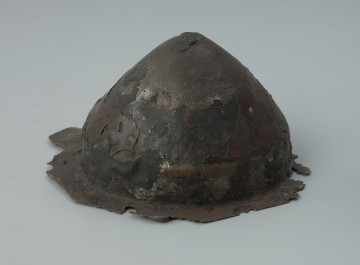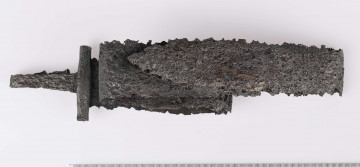
Umbo
National Museum in Szczecin
Part of the collection: Antiquity
The one-edged iron sword was ritually bent before it was placed in the grave as a gift to the deceased. It was a common burial custom practice in the Western Pomerania from the 2nd century BC until the 3rd century AD. Other parts of weapons, such as javelin heads and umbo (shield fittings), were destroyed in the same way. The sword originally rested in a wooden scabbard. What remained from it was a set of eight iron fittings – clasps that held the scabbard together, and a so-called chape, a metal fitting at a bottom of a scabbard. The sword comes from the cemetery of Oksywie culture in Warszkowo near Sławno. It is one of the most important archaeological sites of this culture with over 230 graves. The presented sword is dated to the 2nd-1st century BC. It belonged to the grave goods found in one of the urned cremations - one in which the cremated remains of the deceased were placed in a pottery vessel. Apart from the sword, the grave also contained the iron elements of the warrior’s shield – the umbo, a bowl-shaped fitting at the centre of a shield, and a shield handle. The javelin and shield were the basic equipment of the warrior in the period around the turn of the era. It is rare to find the graves of warriors with a higher social status that were equipped also with swords. In the 2nd - 1st century BC both double-edged and single-edged swords were in use, such as the specimen from Warszków which was typical for the Oksywie culture. The grave was discovered during excavations of the cemetery in the years 1929-1930 under the supervision of a local regionalist and amateur archaeologist, Dieter von Kleist, who was a soldier by profession. He conducted the fieldwork very thoroughly, and the findings and archives from the research have survived to the present day.
Bartłomiej Rogalski
Author / creator
Dimensions
cały obiekt: height: 4.8 cm, width: 25.9 cm
Object type
furnishings and equipment; weapon; sword; single-edged sword
Technique
forging
Material
iron
Creation / finding place
Owner
Muzeum Narodowe w Szczecinie
Identification number
Location / status

National Museum in Szczecin

National Museum in Lublin

National Museum in Lublin
DISCOVER this TOPIC
National Museum in Lublin
DISCOVER this PATH
Educational path